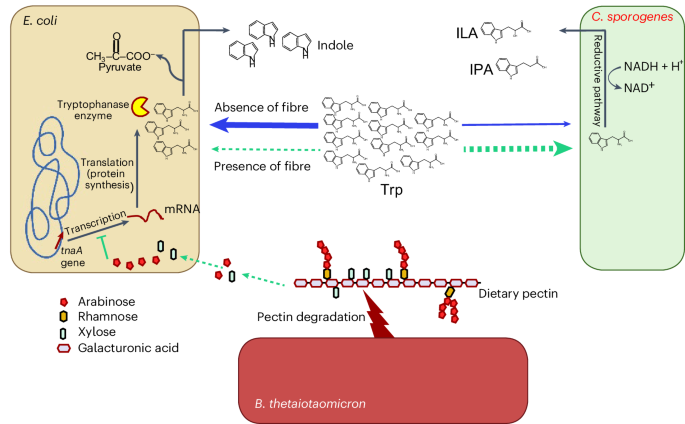This study delves into the complex interactions within the gut microbiome, the metabolism of tryptophan, an essential amino acid, and its conversion into various metabolites. These metabolites have significant implications for human health, with some contributing to chronic conditions such as kidney disease, while others offer protective benefits. The research primarily focuses on how dietary fibers influence the competition between gut microbes for tryptophan, ultimately affecting the production of harmful or beneficial metabolites.
Key Findings:
- The production of specific tryptophan-derived metabolites was found to be influenced not by the mere presence of tryptophan-metabolizing bacteria but rather by the regulation of specific metabolic pathways in response to substrate availability.
- Introducing fiber-degrading bacteria like Bacteroides thetaiotaomicron shifts the metabolic pathway from the production of indole, a precursor to harmful metabolites, towards beneficial ones like indolelactic acid (ILA) and indolepropionic acid (IPA). This occurs via a mechanism called catabolite repression, where monosaccharides from fiber degradation inhibit indole production by E. coli, making more tryptophan available for beneficial pathways.
- With increased availability of tryptophan due to fiber-induced modifications in microbial metabolism, Clostridium sporogenes produces more ILA and IPA. These metabolites are associated with protective effects against diseases.
Methods:
- In Vitro Culturing and Animal Experiments: The researchers employed controlled in vitro culturing alongside animal models to mimic and study the gut microbiome’s behavior under various dietary conditions.
- Three-Species Defined Community and Complex Human Faecal Communities: Both a simple model involving only three microbial species and more complex models using undefined human fecal communities were used to explore how different microbial communities respond to dietary changes and compete for tryptophan.
- Measurement of Metabolite Production: The study quantified the levels of indole, ILA, and IPA under different conditions to understand how dietary fibers and microbial interactions influence these pathways.
Link to the study : https://tinyurl.com/57n8j7pb
